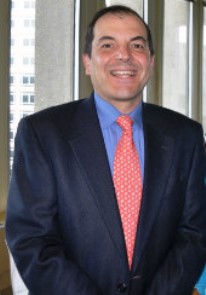Can the equity markets continue their relentless upward momentum? That was the question traders on Wall Street were asking as market indexes breached historic levels.
Last week the U.S. equity market closed in record territory as the Dow Jones finally crossed the 20,000 Maginot line last Wednesday. The current ‘Trump rally’ has been fueled by business-friendly policy and rhetoric out of Washington, relatively inexpensive energy, improving corporate earnings and low rates the Dow recorded 2nd fastest 1,000-point move in history (42 days).
Wow.

What was a Fed/rate driven market, which was preceded by the oil-driven market, has been replaced by a presidential policy/tweet driven market, said Larry Peruzzi, managing director of international trading at Mischler Financial. Fed watching has been replaced by tweet watching and so far equity markets likes what it is seeing. Historically when markets cross into record territory we normally see a brief pause while analysts assess valuations.
- He added that additional positive news was received after the close on last Thursday as earnings from Microsoft, Intel and Alphabet beat estimates. As of Thursday, 161 of the S&P 500 names have reported with 120 (74.5%) reporting a positive surprise and 38 (23.6%) reporting a negative surprise.
This week 24 S&P 500 companies are scheduled to report earnings with retailers leading the pack.
Trading on U.S. equity exchanges was modest last week as traders opted to stay somewhat dormant after the employment data. Trading levels averaged 6.8 billion shares per day for the week ended January 27, compared with 6.38 billion shares the prior week, according to Bats Global Markets data.
Looking to this week, one cannot ignore the economic data laden schedule. The week gives way to Dallas Fed activity reports today, segueing into a FOMC rate decision on Wednesday (no change expected), and then culminating in Fridays January employment report.
In looking at the Fed, Peruzzi noted that the Fed Funds rate, despite Chair Yellens calls for an increased magnitudes of rate increases, is not expected to change. Fed Funds are only pricing a 14.5% probability of a rate hike for Wednesdays FOMC meeting.
Fridays employment reported should see a lot of attention, Peruzzi said. A positive report is sure to be met by the suddenly customary round of tweets and promotion. It may however be a tad bit early to put much emphasis on the report. The April, May and June reports should be much better harbinger of the effectiveness of the Trump agenda toward job creation. With the Dow Jones now over the 20,000 level, after six failed attempts in December and January, we will be looking for signals on the strength and sustainability of the bullish sentiment.
Pimco’s Mohamed El-Erian put out a research commentary last week asking if the hitting of benchmark records mean the current rally is sustainable? El-Erian doesnt think so saying that the attainment of record milestones last week by the DJIA, Nasdaq and S&P might not be enough to further propel the ongoing market rally.
Many hope that all this will act as a catalyst for wider participation of the general population — and millennials in particular — in stock ownership. After all, a bigger investor base is the best contributor to a fundamentally healthy and less volatile market, El-Erian wrote. The problem is that it may take a lot more than headlines and social media likes for this to happen.
El-Erian continue that at the most fundamental level, Dow 20,000 does little to reduce the general mistrust of the financial establishment that was heightened by the 2008 global financial crisis and its aftermath. Still too many people believe that the financial markets are rigged to benefit insiders. Moreover, the stock markets strong performance stands in stark contrast to the general malaise and unsettling feelings resulting from too many years of low and insufficiently inclusive growth, along with an unusual level of uncertainty regarding economic, financial and political conditions.
In other news, Michael Piwowar was designated Acting Chairman of the U.S. Securities and Exchange Commission by President Trump on Jan. 23. Piwowar has been with the SEC since August 2013. Previously, Piwowar was the Republican chief economist for the U.S. Senate Committee on Banking, Housing, and Urban Affairs and lead Republican economist on the four SEC-related titles of the Dodd-Frank Act and the JOBS Act. Dr. Piwowar also worked on a number of important SEC-related oversight issues under the jurisdiction of the Committee, such as securities, over-the-counter derivatives, investor protection, market structure, and capital formation.
Also, the New York Stock Exchange has decided to rename its NYSE MKT Exchangeto NYSE American and introduce a 350-microsecond delay on orders there, according to a statement Wednesday.
Lastly, market consultancy Greenwich Associates released a new report that noted as the ‘commoditization’ of algorithms continues, buy-side traders who use these electronic trading tools are dissatisfied.
The report highlighted that only 7% of buy-side traders are happy with their standard algorithms provided by their brokers, according to new research from market consultancy Greenwich Associates. In a report, Greenwich reported that traders increasingly want a more bespoke or customized electronic trading solution that more closely resembles their trading style and the order types they send or use.
This Weeks U.S. Economic Indicators of Interest:
| Monday |
Personal Income and Outlays New Home Sales Dallas Fed Mfg Survey |
| Tuesday |
Redbook Retail Sales Consumer Confidence Chicago PMI FOMC Meeting Begins |
| Wednesday |
ISM Index Construction Spending FOMC Meeting Announcement |
| Thursday |
Jobless Claims International Trade |
| Friday |
Durable Goods Employment Report Factory Orders Charles Evans Speaks |




